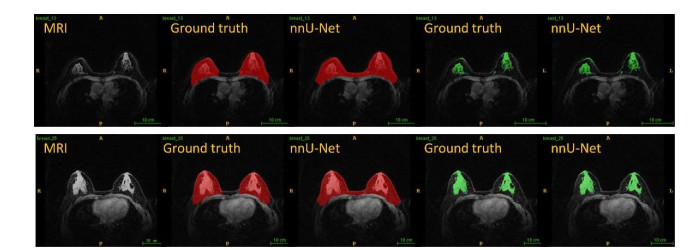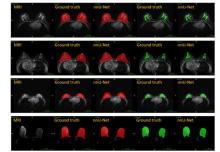
Chinese Journal of Magnetic Resonance ›› 2021, Vol. 38 ›› Issue (3): 367-380.doi: 10.11938/cjmr20212883
• Articles • Previous Articles Next Articles
Lu HUO1,2,Xiao-xin HU3,Qin XIAO3,Ya-jia GU3,Xu CHU1,4,Luan JIANG1,*( )
)
Received:2021-01-14
Online:2021-09-05
Published:2021-03-12
Contact:
Luan JIANG
E-mail:jiangl@sari.ac.cn
CLC Number:
Lu HUO,Xiao-xin HU,Qin XIAO,Ya-jia GU,Xu CHU,Luan JIANG. Automatic Segmentation of Breast and Fibroglandular Tissues in DCE-MR Images Based on nnU-Net[J]. Chinese Journal of Magnetic Resonance, 2021, 38(3): 367-380.

Fig.6
Segmentation examples of two groups with different breast DCE-MR imaging parameters. The top and bottom lines are Group 1 and Group 2. From left to right: the original image, the ground truth of whole breast, the segmentation mask of whole breast, the ground truth of FGT, and the segmentation mask of FGT


Fig.7
Segmentation examples of four groups with different breast density ratings. From top down: Category I, Category Ⅱ, Category Ⅲ and Category Ⅳ (Ⅰ - fatty: < 25%; Ⅱ - scattered: 25% ~ 50%; Ⅲ - heterogeneously dense: 50% ~ 75%; Ⅳ - dense: > 75%). From left to right: the original image, the ground truth of whole breast, the segmentation mask of whole breast, the ground truth of FGT, and the segmentation mask of FGT

Table 4
Performance metrics for segmentation during cross validation (taking DSC as an example)
| 乳房分割 | 腺体分割 | |||
| 验证集 | Fold 1 | 0.970±0.049 | 0.941±0.061 | |
| Fold 2 | 0.982±0.014 | 0.945±0.046 | ||
| Fold 3 | 0.971±0.044 | 0.942±0.047 | ||
| Fold 4 | 0.982±0.016 | 0.946±0.052 | ||
| Fold 5 | 0.975±0.012 | 0.942±0.031 | ||
| 平均值±标准差 | 0.976±0.027 | 0.944±0.047 | ||
| 测试集 | 0.969±0.007 | 0.893±0.054 | ||
| 1 | BOYD N F , GUO H , MARTIN L J , et al. Mammographic density and the risk and detection of breast cancer[J]. New Eng J Med, 2007, 356 (1): 227- 236. |
| 2 |
KLIFA C , CARBALLIDO-GAMIO J , WILMES L , et al. Magnetic resonance imaging for secondary assessment of breast density in a high-risk cohort[J]. Magn Reson Imaging, 2010, 28 (1): 8- 15.
doi: 10.1016/j.mri.2009.05.040 |
| 3 |
WU S D , WEINSTEIN S P , CONANT E F , et al. Automated chest wall line detection for whole-breast segmentation in sagittal breast MR images[J]. Med Phys, 2013, 40 (4): 042301.
doi: 10.1118/1.4793255 |
| 4 |
NIE K , CHEN J H , CHAN S , et al. Development of a quantitative method for analysis of breast density based on three-dimensional automated segmentation of breast in 3-D MR images[J]. Med Phys, 2008, 35 (12): 5253- 5262.
doi: 10.1118/1.3002306 |
| 5 |
GUBERN-MÉRIDA A , KALLENBERG M , MANN R M , et al. Breast segmentation and density estimation in breast MRI: A fully automatic framework[J]. IEEE J Biomed Health, 2015, 19 (1): 349- 357.
doi: 10.1109/JBHI.2014.2311163 |
| 6 |
IVANOVSKA T , LAQUA R , WANG L , et al. A level set based framework for quantitative evaluation of breast tissue density from MRI data[J]. PLoS One, 2014, 9 (11): e112709.
doi: 10.1371/journal.pone.0112709 |
| 7 |
WU S D , WEINSTEIN S P , CONANT E F , et al. Automated fibroglandular tissue segmentation and volumetric density estimation in breast MRI using an atlas-aided fuzzy C-means method[J]. Med Phys, 2013, 40 (12): 122302.
doi: 10.1118/1.4829496 |
| 8 | KOREZ R, LIKAR B, PERNUŠ F, et al. Model-based segmentation of vertebral bodies from MR images with 3D CNNs[C]//Medical Image Computing and Computer-Assisted Intervention-MICCAI 2016. Cham, Switzerland: Springer International Publishing, 2016: 433-441. |
| 9 | MOESKOPS P, WOLTERINK J M, VAN DER VELDEN B H M, et al. Deep learning for multi-task medical image segmentation in multiple modalities[C]//Medical Image Computing and Computer-Assisted Intervention-MICCAI 2016. Cham, Switzerland: Springer International Publishing, 2016: 478-486. |
| 10 | RODRIGUEZ-RUIZ A, TEUWEN J, CHUNG K, et al. Pectoral muscle segmentation in breast tomosynthesis with deep learning[C]//Medical Imaging 2018: Computer-Aided Diagnosis. Bellingham, WA: SPIE, 2018: 564-570. |
| 11 |
ZHANG J , GAO Y Z , PARK S H , et al. Structured learning for 3-D perivascular space segmentation using vascular features[J]. IEEE T Biomed Eng, 2017, 64 (12): 2803- 2812.
doi: 10.1109/TBME.2016.2638918 |
| 12 | CHRIST P, ETTLINGER F, GRÜN F, et al. Automatic liver and tumor segmentation of CT and MRI volumes using cascaded fully convolutional neural networks[EB/OL]. (2017-2-23)[2020-12-19]. https://arxiv.org/pdf/1505.04597v1. |
| 13 | RONNEBERGER O, FISCHER P, BROX T. U-Net: Convolutional networks for biomedical image segmentation[C]//Medical Image Computing and Computer-Assisted Intervention-MICCAI 2015. Cham, Switzerland: Springer International Publishing, 2015: 234-241. |
| 14 | ZHAO S Y , WANG Y J . Classification of Alzheimer's disease patients based on magnetic resonance images and an improved UNet++ model[J]. Chinese J Magn Reson, 2020, 37 (3): 321- 331. |
| 赵尚义, 王远军. 基于磁共振图像和改进的UNet++模型区分阿尔茨海默症患者和健康人群[J]. 波谱学杂志, 2020, 37 (3): 321- 331. | |
| 15 |
KALLENBERG M , PETERSEN K , NIELSEN M , et al. Unsupervised deep learning applied to breast density segmentation and mammographic risk scoring[J]. IEEE Trans Med Imaging, 2016, 35 (5): 1322- 1331.
doi: 10.1109/TMI.2016.2532122 |
| 16 | LIU P , ZHONG Y M , WANG L J . Automatic segmentation of right ventricle in cine cardiac magnetic resonance image based on a dense and multi-scale u-net method[J]. Chinese J Magn Reson, 2020, 37 (4): 456- 468. |
| 刘鹏, 钟玉敏, 王丽嘉. 基于密集多尺度U-net网络的电影心脏磁共振图像右心室自动分割[J]. 波谱学杂志, 2020, 37 (4): 456- 468. | |
| 17 | XIAO L , LOU Y K , ZHOU H Y . A U-Net network-based rapid construction of knee models for specific absorption rate estimation[J]. Chinese J Magn Reson, 2020, 37 (2): 144- 151. |
| 肖亮, 娄煜堃, 周航宇. 用于SAR估计的基于U-Net网络的快速膝关节模型重建[J]. 波谱学杂志, 2020, 37 (2): 144- 151. | |
| 18 |
ZHANG Y , CHEN J H , CHANG K T , et al. Automatic breast and fibroglandular tissue segmentation in breast MRI using deep learning by a fully-convolutional residual neural network U-Net[J]. Acad Radiol, 2019, 26 (11): 1526- 1535.
doi: 10.1016/j.acra.2019.01.012 |
| 19 | DALMIŞ M U , LITJENS G , HOLLAND K , et al. Using deep learning to segment breast and fibroglandular tissue in MRI volumes[J]. Med Phys, 2017, 44 (12): 533- 546. |
| 20 | PIANTADOSI G, SANSONE M, SANSONE C. Breast segmentation in MRI via U-Net deep convolutional neural networks[C]//Proceedings of 2018 International Conference on Pattern Recognition (ICPR). Piscataway, NJ: IEEE press, 2018: 3917-3922. |
| 21 |
JIANG L , HU X X , XIAO Q , et al. Fully automated segmentation of whole breast using dynamic programming in dynamic contrast enhanced MR images[J]. Med Phys, 2017, 44 (6): 2400- 2414.
doi: 10.1002/mp.12254 |
| 22 | ISENSEE F, PETERSEN J, KLEIN A, et al. nnU-Net: Self-adapting framework for U-Net-based medical image segmentation[EB/OL]. (2018-9-27)[2020-12-19]. https://arxiv.org/abs/1809.10486v1 |
| 23 |
HELLER N , ISENSEE F , MAIER-HEIN K H , et al. The state of the art in kidney and kidney tumor segmentation in contrast-enhanced CT imaging: Results of the KiTS19 challenge[J]. Med Image Anal, 2021, 67, 101821.
doi: 10.1016/j.media.2020.101821 |
| 24 | MA J, WANG Y X, AN X L, et al. Toward data-efficient learning: A benchmark for COVID-19 CT lung and infection segmentation[J]. Med Phys, 2020. https://doi.org/10.1002/mp.14676. |
| 25 | PAUL S H . Graphics gems Ⅳ[M]. San Francisco: Margan Kaufmann, 1994, 474- 485. |
| 26 |
YUSHKEVICH P A , PIVEN J , HAZLETT H C , et al. User-guided 3D active contour segmentation of anatomical structures: Significantly improved efficiency and reliability[J]. NeuroImage, 2006, 31 (3): 1116- 1128.
doi: 10.1016/j.neuroimage.2006.01.015 |
| 27 | LÓPEZ-LINARES ROMÁN K , GARCÍA OCAÑA M I , LETE URZELAI N , et al. Medical image segmentation using deep learning[J]. Intelligent Systems Reference Library, 2020, 171, 17- 31. |
| [1] | LIU Peng, ZHONG Yu-min, WANG Li-jia. Automatic Segmentation of Right Ventricle in Cine Cardiac Magnetic Resonance Image Based on a Dense and Multi-Scale U-net Method [J]. Chinese Journal of Magnetic Resonance, 2020, 37(4): 456-468. |
| [2] | ZHAO Shang-yi, WANG Yuan-jun. Classification of Alzheimer's Disease Patients Based on Magnetic Resonance Images and an Improved UNet++ Model [J]. Chinese Journal of Magnetic Resonance, 2020, 37(3): 321-331. |
| [3] | GONG Jin-chang, WANG Yu, WANG Yuan-jun. A Method for Segmentation of Glioma on Multimodal Magnetic Resonance Images Based on Wavelet Fusion and Deep Learning [J]. Chinese Journal of Magnetic Resonance, 2020, 37(2): 131-143. |
| [4] | CHENG Hui-tao, WANG Shan-shan, KE Zi-wen, JIA Sen, CHENG Jing, QIU Zhi-lang, ZHENG Hai-rong, LIANG Dong. A Deep Recursive Cascaded Convolutional Network for Parallel MRI [J]. Chinese Journal of Magnetic Resonance, 2019, 36(4): 437-445. |
| [5] | SU Xin-yu, WANG Li-jia, NIE Sheng-dong, HU Li-wei, ZHONG Yu-min. Progress of Right Ventricle Segmentation from Short-Axis Images Acquired with Cardiac Cine MRI [J]. Chinese Journal of Magnetic Resonance, 2019, 36(3): 377-391. |
| Viewed | ||||||
|
Full text |
|
|||||
|
Abstract |
|
|||||